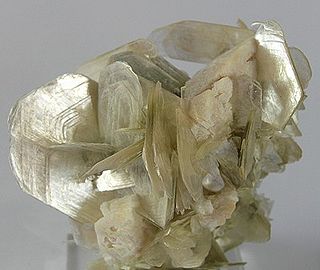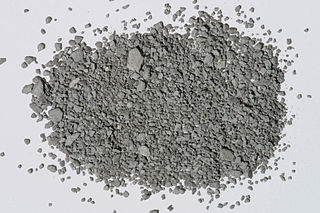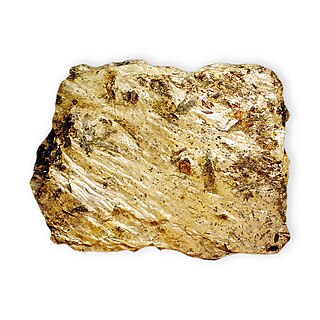Related Research Articles

Muscovite (also known as common mica, isinglass, or potash mica) is a hydrated phyllosilicate mineral of aluminium and potassium with formula KAl2(AlSi3O10)(F,OH)2, or (KF)2(Al2O3)3(SiO2)6(H2O). It has a highly perfect basal cleavage yielding remarkably thin laminae (sheets) which are often highly elastic. Sheets of muscovite 5 meters × 3 meters (16.5 feet × 10 feet) have been found in Nellore, India.

Schist is a medium-grained metamorphic rock showing pronounced schistosity. This means that the rock is composed of mineral grains easily seen with a low-power hand lens, oriented in such a way that the rock is easily split into thin flakes or plates. This texture reflects a high content of platy minerals, such as mica, talc, chlorite, or graphite. These are often interleaved with more granular minerals, such as feldspar or quartz.

Metamorphic rocks arise from the transformation of existing rock to new types of rock in a process called metamorphism. The original rock (protolith) is subjected to temperatures greater than 150 to 200 °C and, often, elevated pressure of 100 megapascals (1,000 bar) or more, causing profound physical or chemical changes. During this process, the rock remains mostly in the solid state, but gradually recrystallizes to a new texture or mineral composition. The protolith may be an igneous, sedimentary, or existing metamorphic rock.

Amphibole is a group of inosilicate minerals, forming prism or needlelike crystals, composed of double chain SiO
4 tetrahedra, linked at the vertices and generally containing ions of iron and/or magnesium in their structures. Its IMA symbol is Amp. Amphiboles can be green, black, colorless, white, yellow, blue, or brown. The International Mineralogical Association currently classifies amphiboles as a mineral supergroup, within which are two groups and several subgroups.

Silicate minerals are rock-forming minerals made up of silicate groups. They are the largest and most important class of minerals and make up approximately 90 percent of Earth's crust.

Glaucophane is the name of a mineral and a mineral group belonging to the sodic amphibole supergroup of the double chain inosilicates, with the chemical formula ☐Na2(Mg3Al2)Si8O22(OH)2.

The chlorites are the group of phyllosilicate minerals common in low-grade metamorphic rocks and in altered igneous rocks. Greenschist, formed by metamorphism of basalt or other low-silica volcanic rock, typically contains significant amounts of chlorite.

Blueschist, also called glaucophane schist, is a metavolcanic rock that forms by the metamorphism of basalt and rocks with similar composition at high pressures and low temperatures, approximately corresponding to a depth of 15–30 km (9.3–18.6 mi). The blue color of the rock comes from the presence of the predominant minerals glaucophane and lawsonite.

Illite, also called hydromica or hydromuscovite, is a group of closely related non-expanding clay minerals. Illite is a secondary mineral precipitate, and an example of a phyllosilicate, or layered alumino-silicate. Its structure is a 2:1 sandwich of silica tetrahedron (T) – alumina octahedron (O) – silica tetrahedron (T) layers. The space between this T-O-T sequence of layers is occupied by poorly hydrated potassium cations which are responsible for the absence of swelling. Structurally, illite is quite similar to muscovite with slightly more silicon, magnesium, iron, and water and slightly less tetrahedral aluminium and interlayer potassium. The chemical formula is given as (K,H3O)(Al,Mg,Fe)2(Si,Al)4O10[(OH)2·(H2O)], but there is considerable ion (isomorphic) substitution. It occurs as aggregates of small monoclinic grey to white crystals. Due to the small size, positive identification usually requires x-ray diffraction or SEM-EDS analysis. Illite occurs as an altered product of muscovite and feldspar in weathering and hydrothermal environments; it may be a component of sericite. It is common in sediments, soils, and argillaceous sedimentary rocks as well as in some low grade metamorphic rocks. The iron-rich member of the illite group, glauconite, in sediments can be differentiated by x-ray analysis.

Paragonite is a mineral, related to muscovite. Its empirical formula is NaAl2(AlSi3O10)(OH)2. A wide solvus separates muscovite from paragonite, such that there is little solid solution along the vector Na+K+ and apparent micas of intermediate composition is most commonly a microscopic (or even sub-microscopic) intergrowth of two distinct micas, one rich in K, and the other in Na. Paragonite is a common mineral in rocks metamorphosed under blueschist facies conditions along with other sodic minerals such as albite, jadeite and glaucophane. During the transition from blueschist to greenschist facies, paragonite and glaucophane are transformed into chlorite and albite. Jadeite bearing pyroxene minerals have suggested clinozoisite and paragonite are associated and derived from lawsonite releasing quartz and water via the following reaction:

Lawsonite is a hydrous calcium aluminium sorosilicate mineral with formula CaAl2Si2O7(OH)2·H2O. Lawsonite crystallizes in the orthorhombic system in prismatic, often tabular crystals. Crystal twinning is common. It forms transparent to translucent colorless, white, pink, and bluish to pinkish grey glassy to greasy crystals. Refractive indices are nα = 1.665, nβ = 1.672 – 1.676, and nγ = 1.684 – 1.686. It is typically almost colorless in thin section, but some lawsonite is pleochroic from colorless to pale yellow to pale blue, depending on orientation. The mineral has a Mohs hardness of 7.5 and a specific gravity of 3.09. It has perfect cleavage in two directions and a brittle fracture. Not to be confused with Larsonite, a fossiliferous jasper mined in Nevada.
Stuart Olof Agrell was an optical mineralogist and a pioneer in applications of the electron microprobe to petrology. His involvement as a principal investigator in the analysis of Moon rocks collected in the Apollo program brought him to the attention of the British media and public.

Phengite is a series name for dioctahedral micas of composition K(Al,Mg)2(OH)2(Si,Al)4O10. It is common for Mg or Fe2+ to substitute for Al on the Y site and a corresponding increase in Si on the Z site in the mica group formula X2Y4–6Z8O20(OH, F)4. Similar to muscovite but with addition of magnesium. It is a non-IMA recognized mineral name representing the series between muscovite and celadonite.
William Alexander (Alex) Deer FRS was a distinguished British geologist, petrologist and mineralogist.

Cookeite is a mineral species of the silicate group and the phyllosilicate subgroup, part of the chlorite family, with the formula LiAl4(Si3Al)O10(OH)8. This soft, low-density mineral of variable color has a crystalline structure made up of alternating layers LiAl2(OH)6 and Al2O4(OH)2Si8O12 having several polytypes. Cookeite is often found as a product of hydrothermal alteration of silicates in pegmatites. It forms at relatively low temperatures (below 200 °C) and variable pressures.

Pimelite was discredited as a mineral species by the International Mineralogical Association (IMA) in 2006, in an article which suggests that "pimelite" specimens are probably willemseite, or kerolite. This was a mass discreditation, and not based on any re-examination of the type material. Nevertheless, a considerable number of papers have been written, verifying that pimelite is a nickel-dominant smectite. It is always possible to redefine a mineral wrongly discredited.
Robert Andrew Howie was a notable English petrologist.

Ferronigerite-2N1S is an iron, tin, alumino-hydroxide mineral that naturally occurs around sillimanite-quartz veins. Ferronigerite-2N1S belongs to the nigerite group, högbomite supergroup. The other constituents of the nigerite group are ferronigerite-6N6S, magnesionigerite-2N1S, magnesionigerite-6N6S, zinconigerite-2N1S and zinconigerite-6N6S. The 2N1S ending stands for the nolanite and spinel structural layers.

A subduction zone is a region of the Earth's crust where one tectonic plate moves under another tectonic plate; oceanic crust gets recycled back into the mantle and continental crust gets produced by the formation of arc magmas. Arc magmas account for more than 20% of terrestrially produced magmas and are produced by the dehydration of minerals within the subducting slab as it descends into the mantle and are accreted onto the base of the overriding continental plate. Subduction zones host a unique variety of rock types formed by the high-pressure, low-temperature conditions a subducting slab encounters during its descent. The metamorphic conditions the slab passes through in this process generates and alters water bearing (hydrous) mineral phases, releasing water into the mantle. This water lowers the melting point of mantle rock, initiating melting. Understanding the timing and conditions in which these dehydration reactions occur, is key to interpreting mantle melting, volcanic arc magmatism, and the formation of continental crust.

Antigorite is a lamellated, monoclinic mineral in the phyllosilicate serpentine subgroup with the ideal chemical formula of (Mg,Fe2+)3Si2O5(OH)4. It is the high-pressure polymorph of serpentine and is commonly found in metamorphosed serpentinites. Antigorite, and its serpentine polymorphs, play an important role in subduction zone dynamics due to their relative weakness and high weight percent of water (up to 13 weight % H2O). It is named after its type locality, the Geisspfad serpentinite, Valle Antigorio in the border region of Italy/Switzerland and is commonly used as a gemstone in jewelry and carvings.
References
- ↑ Zussmanite, Mindat.org
- ↑ "Zussmanite Mineral Data". Webmineral.com.
- ↑ Anthony, John W.; Bideaux, Richard A.; Bladh, Kenneth W.; Nichols, Monte C. (2005). "Zussmanite" (PDF). Handbook of Mineralogy. Mineral Data Publishing. Retrieved 14 March 2022.
- Agrell, S.O.; Bown, M.G.; McKie, D. (1965). "Deerite, howieite and zussmanite, three new minerals from the Franciscan of the Laytonville District, Mendocino County, California" (PDF). American Mineralogist. 50: 278.
- Deer, W.; Howie, R; Zussman, J. (1993). An introduction to the rock-forming minerals (2nd ed.). Pearson Education Limited.
- Dempsey, M.J. (1981). "Zussmanite Stability; A Preliminary Study". Progress in Experimental Petrology. 5: 58–60.
- Lopes-Vieira, A.; Zussman, J. (1967). "The Crystal Structure of the Mineral Zussmanite" (PDF). Mineralogical Magazine. 36 (278): 292–293. Bibcode:1967MinM...36..292L. doi:10.1180/minmag.1967.036.278.11.
- Lopes-Vieira, A.; Zussman, J. (1969). "Further Detail on the Crystal Structure of Zussmanite" (PDF). Mineralogical Magazine. 37 (285): 28–60. Bibcode:1969MinM...37...49L. doi:10.1180/minmag.1969.037.285.06.
- Massonne, H.-J.; Hervé, F.; Medenbach, O.; Muñoz, V.; Willner, A. P. (December 1998). "Zussmanite in ferruginous metasediments from Southern Central Chile". Mineralogical Magazine. 62 (6): 869–876. doi:10.1180/002646198548098.
- Miyashiro, Akiho (1973). Metamorphism and metamorphic belts. London: G. Allen & Unwin. ISBN 978-0045500178.